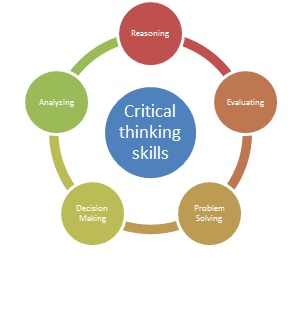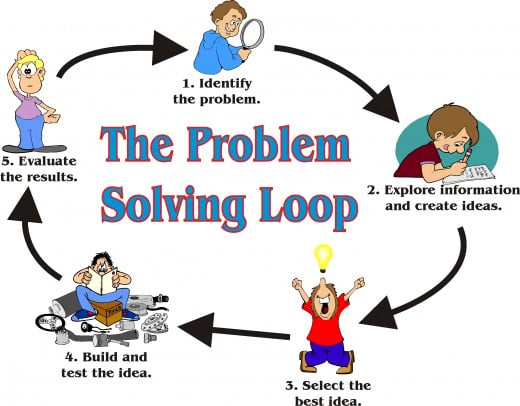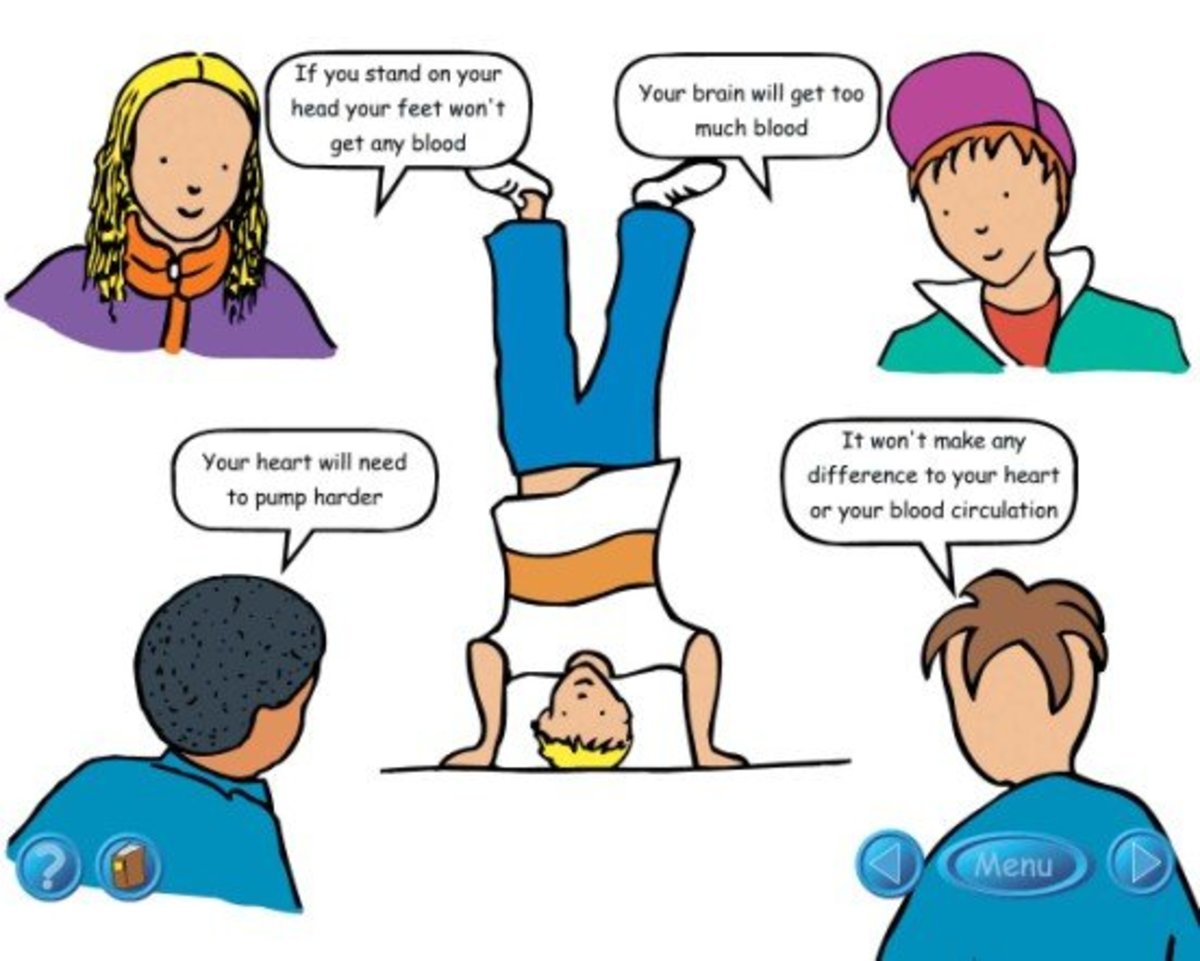Using Critical Thinking Skills in Your Everyday Life
Actions of Critical Thinking
There are steps to help in making a plan and being prepared in an emergency with a backup plan. A person never knows when a problem is going to come about. These skills can be used at work or at home.
- Understanding/Knowledge - Mary should have had a backup plan but she wasn't prepared as to what might or could happen. Having a clear understanding of possible problems that could arise in the future would have benefited her saving her money, loss of work and having someone to step in an emergency. Brainstorming using the knowledge of possible problems that may pop up suddenly by making a list of all the problems that may or may not happen can help in an emergency can prevent a lot of extra problems.
- Comprehension/ Perception - After brainstorming now Mary needs to make a list of possible solutions to solve any problems that could happen in the future. She should be able to grasp the perception the ability to know or understand what she needs to do in order to correct any problems that could arise in the future.
- Evaluate/Application - Now that Mary has made a list of possible solutions, she will need to evaluate the outcome of each solution. She will need to research the solutions to see if they will work out. In Mary case, this will require calling/talking to the people to determine if they will be able to step in an emergency to help out if the sitter can't make it. This will require taking notes about their conversation with each person she spoke with to determine if her backup plan will work out. Documenting their talks will keep her focused on what each person said so can better evaluate if the application process will benefit her in an emergency rather than try and remember who said what about being able to help in an emergency.
- Facts/Analysis - Mary has spoken with others to find possible, solution, so now it's time to put the facts that she learned in an organized list. Then Mary will need to study the facts to determine how it will work in relations to solving any future of needing a sitter at the last minute to prevent loss of work, losing a day's pay and no one to sit with the children. After carefully studying to analysis each possible solution to determine all the facts, it will be time to move to the last step.
- Combining Information Learned/Synthesis - Mary will now begin to make a schedule or daily planner to list who is available on what days to step in to sit with the children or give her a ride if needed. Some may only be available on certain days while others may only be available during certain hours. Refer to the list/table to see Mary backup plan in place showing each step.
What is Critical Thinking Skills?
In our everyday lives, we need to find the solution to problems that may arise without any prior warning. Many families have both parents working or a single parent working, then children have different activities during summer and after school. Then when we plan for the day, week, bio-monthly or monthly, we know what to needs to be done and when, without the last minute rush. Here is an example:
- Mary needs to be at work at eight o'clock in the morning.
- The sitter Sandy is to be there at seven o'clock in the morning to finish getting the children ready for school and put them on the bus.
- Then Sandy is supposed to meet Randy at one in the afternoon at the bus stop and take him back home, plus give him a snack.
- Now Sandy stays there until Mary gets home from work at 5:30 pm, and has their supper ready to eat when Mary gets home.
Now Mary runs into a problem this morning. Sandy has called at 6:45 am to inform Mary, she won't be able to make it this morning. Sandy has had a family emergency and has to go the hospital and also tells Mary, she won't be able to pick the children up from school either.
Mary has no backup plan in place. Who is she going to call that early in the morning, and have them there on time with such a short notice? Well, Mary will have to miss work today, no one is available. By missing work, she lost a whole day's pay, which might cut her short at the end of the week on her finances.
If Mary had made a backup plan this problem would have been easy to solve. What could Mary have done differently? Now, look at how critical thinking and having a well thought out plan could have solved the problem, at the most Mary would have been fifteen minutes to a half an hour late for work instead of missing a whole day of work.
Let us say Mary plans each week out ahead:
- Mary makes arrangements ahead of time with a neighbor in case Sandy can't make it babysit the children. Solves the problem of a babysitter.
- In case Mary's car breaks down, she has also made arrangements with another neighbor or friend that can pick her up and take her to work. Mary can call a cab to bring her home or get a ride from someone she works with that she has asked in advance in case she had car trouble. Car problem solved.
- The two oldest have different activities after school. Mary can make arrangements with another child's parents to take one of the children back and forth, picking them up at their house after she gets the one child from activities. The problem is solved.
Having a well-planned course of action in place in a situation can solve many problems.
Comprehension/Perception/Possible Solutions - Step Two
Now let's look at some possible solutions to the problems that may occur in the future from the list of questions in the first step.
- Will ask Lorie, Martha, Beth, Cathy, and Liz if they would be available in case of an emergency where I need a sitter.
- Martha and Liz don't have other jobs but the others have jobs and other functions that they are a member of.
- There are five people who can fill in an emergency, however; one person isn't very dependable.
- Three people live close by within five to eight minutes away but two people live twenty to thirty minutes away.
- Only one person isn't very dependable.
- One person would only be available in the morning hours due to their work schedule.
- The children know the extra sitters but not as well as they know Sandy.
- Liz isn't much on keeping a routine, as she prefers the spur of the moment.
- Plan on a quick meal or either bring home take out food.
- Check with three people from work to see if they can give me a ride if my car breaks down.
- One person lives close by about ten minutes away that maybe I can get a ride from.
- After work, I can see if there is anyone who can give me a ride home or call a taxi.
- There are four people Mary could ask if they could pick up the children from their afternoon activities after school, two from each child's activity.
- Hopeful that each person will be available that I speak with.
- Joe, Terry, Lisa, and Linda may be available in an emergency that they pick up the children from afternoon activities.
Underatanding/Knowledge - Step One
Mary needs to begin by making a list of problems that could become a problem in the future so she needs to have a clear understanding what those problems could consist of. Mary has three children, Micky is eleven years old, active in sports after school, Cheryl is eight years old, active in the drama club after school, and Randy is five years old but comes home from school at one o'clock in the afternoon after lunch. Mary has to be at work at eight o'clock and gets off work at five o'clock because they get an hour lunch without pay.
- All three children catch the bus at seven-forty-five every morning.
- Randy gets a snack when he gets home at one pm after the sitter meets him at the bus stop.
- After school, if no activities they get home around three-twenty in the afternoon and are given a snack to hold them to supper time.
- When the children get home, they begin working on their homework.
- Micky has sport's activities on Monday, Wedsnday, Friday from three pm to five pm.
- Cheryl has drama class on Tuesday, Thursday from three pm to five pm.
- Supper is prepared by the sitter and ready at five-thirty when Mary gets home.
- Mary's car is about fifteen years old.
Mary has made a list of the daily routine activities that occur every week excluding Saturday and Sundays since she doesn't work those days, however; she does need to include those days since the two oldest children sometimes have sport's or drama club meetings.
- Every Saturday Micky has a sport's meeting/game starting at one pm to three pm.
- Cheryl has a drama club meeting every other Saturday from noon to two pm.
List the problems that might occur suddenly without advanced warning:
- Who will take care of the children if Sandy can't because of personal problems, on a moment notice?
- Will the person only be available certain days or hours during an emergency?
- Should I try to find more than one person to fill in an emergency in case they can't either?
- Should the person live close by so I can get to work without being more than an hour late?
- How dependable will the person be in an emergency?
- Will the person be able to pick up Randy at the bus stop or Micky and Cheryl from their afternoon school activities?
- How well do my children know the person that will fill in an emergency?
- Will this person keep to the children regular routine of activities?
- Should the person fix supper and have it ready at five-thirty pm like Sandy does or should I just fix a quick supper that night?
- What happens if I have car trouble and need a ride to work?
- Is there anyone close by who could give me a ride?
- How can I get home from work in an emergency if my car needs repairs?
- Is there anyone in the children's afternoon activities after school that could pick the children up and sits with them until I get off work or brings them home in an emergency if the person filling in is unable to pick them up?
- Should I look for more than one person to fill in an emergency for the children after school activities?
- On Saturday afternoon school activities should I locate more than one person to take the children back and forth if my car is broke down?
Now that we have been brainstorming a list, it is now time to move to the second step, however; you may need to revise this list as you progress to the next step or you may need to revise first four steps as you find that you missed something, this is not uncommon.
Evaluate/Application - Third Step
Mary will now start calling people she has decided to ask in an emergency to sit with the children. Notes will be needed so that when she does the final step to organize her list to be better prepared in an emergency, she will know who can fill in what days or whom she can get a ride to work from.
- Extra Sitters - Martha stated she is available anytime, and she only lives five minutes away. Liz is available anytime but will need forty-five to get there as she lives half an hour away. Lorie can only sit with the children on Monday and Wednesday's but Mary will need to pick them up at her house and find someone to drop them off after school activities. Beth can only sit with the children on Tuesday and Thursday with no problem with picking up the children after school activities. Cathy is only available in the morning hours as she needs to be at work at noon, on Wednesday and Friday.
- After School Activities Ride - Joe can take Micky home or to the sitter house after school activities but can't keep him because he has to go to work. Terry is available to pick up Randy after school activities which she can keep him or drop him off with the sitter. Lisa can only pick up Cheryl on Thursday's, her day off from work but she can keep her or drop her off with the sitter. Linda is available both days after school activities but needs to drop Cheryl off either at home or with the sitter, as she has to go work.
- Ride To Work Or Home - Mark lives close by about ten minutes away and can take Mary to work but on Monday, Wednesday and Friday, he has bowling league so she will find a way home on those days. Marie can only take Mary home on Monday and Thursday since she gives rides to two other people the other week days going in the opposite direction of Mary's home. Toni can give Mary a ride to work but also give her a ride home on Wednesday, and Friday since she has a group meeting after work the other weekdays.
Facts/Analysis - Step Four
Now that Mary has gathered her information after researching, and speaking with other people, it is now time to look at all the facts to determine her best method of being prepared in an emergency. Refer to the tables to see how the facts will work to benefit Mary in an emergency.
Extra Sitters/Available Hours
Extra Sitters
| Hours Available
| Conditions
|
|---|---|---|
Martha
| Anytime
| None
|
Liz
| Anytime
| 45 minute notice
|
Lori
| Monday/Wednesday
| Pick up at her house
|
Beth
| Tuesday/Thursday
| Can't pickup after school
|
Cathy
| Wednesday/Friday
| Mornings only
|
List of emergency sitters with days and hours available. After speaking to each person, this is the schedule that will work in an emergency.
Randy/Cheryl Ride Afternoon Activities
Afternoon Activities Ride
| Child
| Available
|
|---|---|---|
Joe
| Micky
| Yes/Home
|
Terry
| Micky
| Yes/Home/Stay
|
Lisa
| Cheryl
| Thursday/Home/Stay
|
Linda
| Cheryl
| Yes/Home
|
The children can get a ride home or stay but Mary may have to pick them up.
Mary's Transportation
Ride
| Available
| Special Conditions
|
|---|---|---|
Mark
| Yes to Take Work/Home
| Monday/Wednesday/Friday-Can't Take Home
|
Marie
| Yes To Take Work/Home
| Unavailable Monday/Thursday
|
Toni
| Yes to Take Work/Home
| None
|
These people can Mary a ride but some day two of them can't take her back home.
Combining Information Learned/Synthesis - Step Five
Now that Mary has been over the information she has gathered and studied all the facts, she is now ready to finalize her plan of action in case of an emergency. Every week Mary will need to check with the people in her backup plan to be sure they can continue to support her in the case of an emergency.
- Extra Backup Sitters: Martha (she lives next door and is available on a moment notice), Liz (lives about thirty minutes away, but is available within forty-five minutes).
- Children Afternoon Ride From School Activities/Weekend Ride: Terry is available to give Micky a ride. Linda is available to give Cheryl a ride. (Mary doesn't know but only parents in their after school activities, so her choices are limited).
- Mary's Transportation: Toni is available anytime so Mary chooses her but will keep Mark for morning ride since he lives close by.
5 Tips To Improve Your Thinking - Samantha Agoos
Life's Lesson Learned
This is from my own personal experience of not having a backup plan in place using critical thinking skill. Had I been prepared for an emergency, I wouldn't have lost a day of work pay. Thinking all I needed was one babysitter was my mistake, which I should have planned ahead in case the sitter couldn't make it.
- That morning I was to be at work at seven am but at the last minute, the sitter calls and states, I can't make it today, stayed out too late last night, better find someone else today.
- Normally the sitter showed up at six-thirty every morning like clock work so I would leave and have a half an hour to get to work.
- My job of being a nurse required that I call in at least two hours before my shift was to start. Now if I don't work that day's shift then tomorrow on the holiday, I will lose my holiday pay since you are required to work your scheduled shift the day before and day after.
- The head nurse told me I had one hour to be at work and I would have to stay over an hour in order to get my holiday pay, well I couldn't locate another sitter on such short notice. I missed the whole day of work plus lost my extra holiday pay.
- After the holiday, the head nurse came up to me and told me I should take a class on critical thinking skills so that I would be better prepared next time in an emergency. I took that class online and learned many valuable tools that I could use in my everyday life.
There were many skills taught in that class that I could benefit from. I learned how to manage my time to be more productive, not only in my personal life but also how to better manage my time at work. These are life long skills that a person can use throughout their life.
Critical Thinking Skills Diagram

1) critical thinking is not just thinking, but thinking which entails self-improvement
2) this improvement comes from skill in using standards by which one appropriately assesses thinking. To put it briefly, it is self-improvement (in thinking) through standards (that assess thinking).
— Think magazine (April ’’92), Richard PaulCritical Thinking
Steps Of Critical-Thinking
- Understand the problem and identify that a problem could happen suddenly. Being prepared ahead of time, start to identify what could go wrong.
- Examine all the possible problems, causes and what solutions that will solve the problem when an emergency arises. This is where you begin brainstorming by making a list or flowchart. Problems not only can happen in everyday life but also while you are at work.
- Now could this problem become real or not? What if any is there any evidence to support your reason for solving a problem before it becomes a problem? Have you thought thru all the things that could go wrong? Can you validate your reason for solving the problem ahead of time?
- What are the alternatives available? What are the implications? Looking at the evidence are solutions available? What are your options? Are there obstacles? Are there consequences? Can the obstacles and consequences be fixed or solved? Are your goals being meet?
- Once you answered the above answers, then you need to implement the best alternative after choosing the best plan or method to solve any problem that may pop up suddenly and begin to put it into action.
Critical thinking is the intellectually disciplined process of actively and skillfully conceptualizing, applying, analyzing, synthesizing, and/or evaluating information gathered from, or generated by, observation, experience, reflection, reasoning, or communication, as a guide to belief and action.
Critical Thinking as Defined by the National Council for Excellence in Critical Thinking, 1987
— National Council for Excellence in Critical ThinkingThinker Person Sit

Four Facts Of Critical Thinkers
According to S.M. Rayhaul Islam an Independent Researcher at Educational, Social, Youth Issues, had this to say about the four different types of critical thinking skills:
"A good critical thinker knows how to separate facts from opinions, how to examine an issue from all sides, how to make rational inferences and how to withhold personal judgment or biases.
- Rational critical thinkers are generally the voices of reason in times of mass hysteria or panic. As Franklin D. Roosevelt said, "We have nothing to fear but fear itself." The critical thinker usually has the comprehensive skills to consider all possible options and solve a problem.
- The critical thinker remains calm and knows when he is right. Critical thinkers are less likely to fall for scams or tricks because they approach everything with a healthy amount of skepticism. Those who lack critical thinking skills often assume that everything they hear is true, regardless of the source.
- Critical thinkers consider all options before they act. If time is an important factor, they consider the fastest method of achieving a goal. They may even discover a shortcut. Critical thinkers embody the phrase "work smarter, not harder." They are masters of efficiency.
- A critical thinker has the self-awareness to know the difference between a rational thought based on careful consideration and an emotional response based on personal bias. Emotion is the enemy of reason. By understanding your own perspective, you can also consider the perspective of others and come to a conclusion based on fact, not feelings."










